Our Y at Potter Park
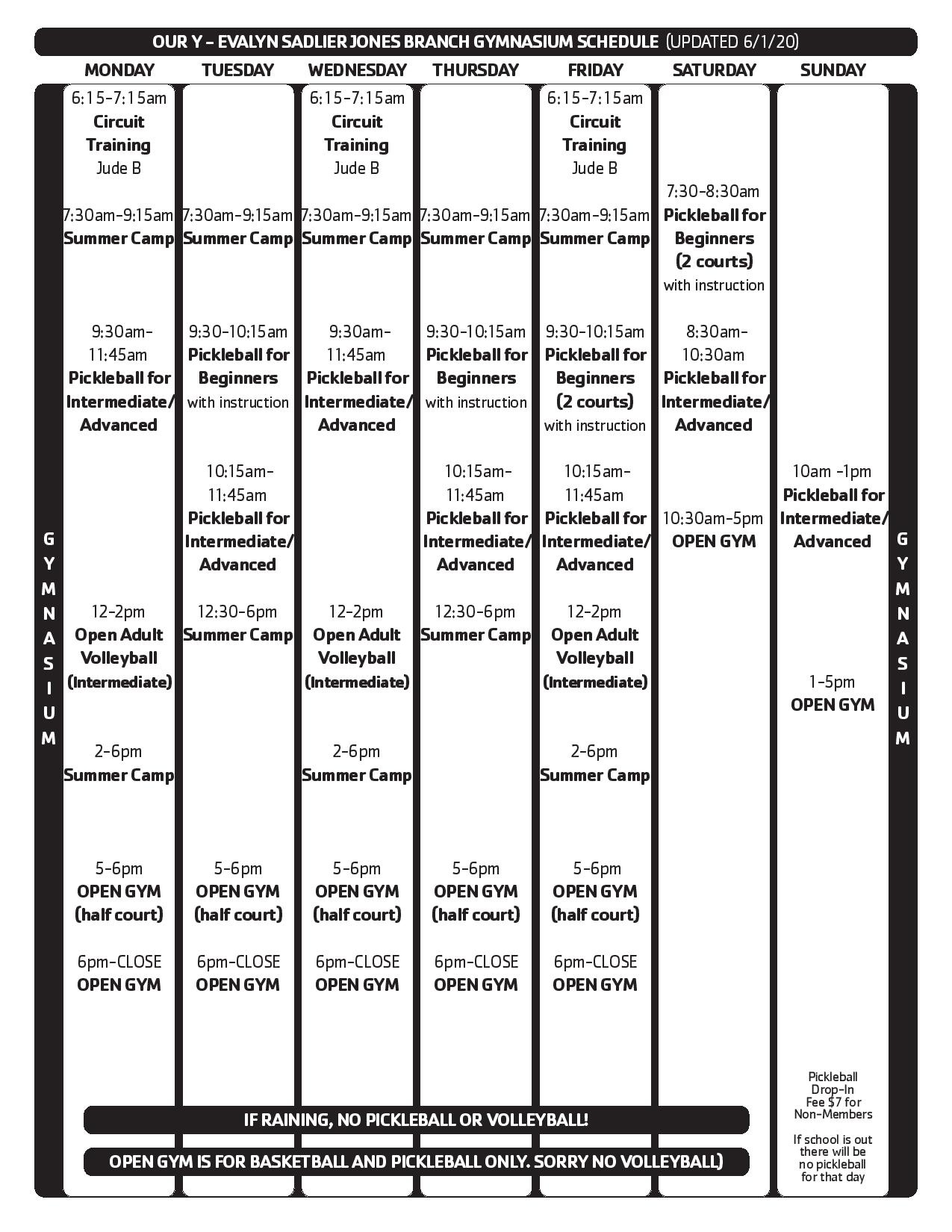
Our Y at Potter Park

 When I first started out playing pickleball, I found it very hard to maintain my focus. Little things would steal my concentration; a yell “OUT!” from another court, people walking behind the court I’m playing on, or just someone new walking in the door. And the minute something steals my attention whoosh there goes a ball by me.
When I first started out playing pickleball, I found it very hard to maintain my focus. Little things would steal my concentration; a yell “OUT!” from another court, people walking behind the court I’m playing on, or just someone new walking in the door. And the minute something steals my attention whoosh there goes a ball by me.
Here is a video on improving your mental focus.
Sometimes my mind will wander, and I’ll even start thinking about my shopping list, or other errands I should do after pickleball. All the above is not good for your game. Your mind should be on one thing, and that is the next shot. Not even the hopeful outcome of the game, but your next shot. Meaning; don’t get ahead of yourself.
You can become rattled by a bad shot you made, or even by the opponents saying the incorrect score, and you’re thinking, wasn’t it 2 – 4? How did they get 3? Meanwhile, the ball is going back and forth and you are still thinking of the score. Not good! Your head should be in the game. What is happening right now? Where are your opponents’ weaknesses? Who has the weak backhand?
There are some tricks to keeping your mind in the game. As the ball is moving back and forth, pickleball pro Sarah Ansboury, likes to point her paddle in the direction of the ball. She feels this keeps her focused.
(Check out this video by Sarah Ansboury-What’s in my bag?)
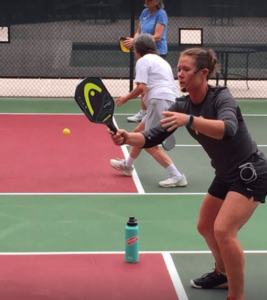
Another way, is to say “ball” (to yourself) as the ball is coming towards you, and another pro told me to look for the holes in the ball. It’s hard to be distracted when you are focusing on the ball.
I would recommend getting into your game head. As soon as you step onto the court clear your mind of everything else. Say to yourself, I am only thinking about this game. Between points, I will tap my hat with my paddle and that is code to my brain to FOCUS! You can tap your knee or squeeze your paddle as a way to get ready. But please don’t slap your thigh with your paddle so it creates a loud SLAP. That is neither helpful or comforting to your partner.
If you miss a shot, don’t continue to think about it. Shake it off. Tap your knee. Focus on the next rally. If someone rolls their eyes at you or gives you a smirk, ignore! Ignore! Ignore! Think only about winning the next shot.
In a tournament, one of the opponents’ strategies is to call a time out if you and your partner are getting way ahead in points. This is a method to break your concentration. Take this time, for a water break and keep thinking about the game. When you get back on the court, stay on the balls of your feet, give your partner a little encouragement with a tap of the paddles, a look meaning “we’ve got this!” and proceed where you left off.
To summarize, stay FOCUSED!
By Pickleball Terry
USAPA Sarasota Ambassador
Creator or SarasotaPickleball.com
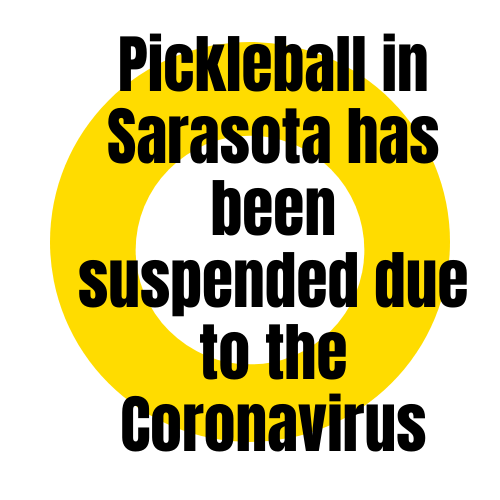
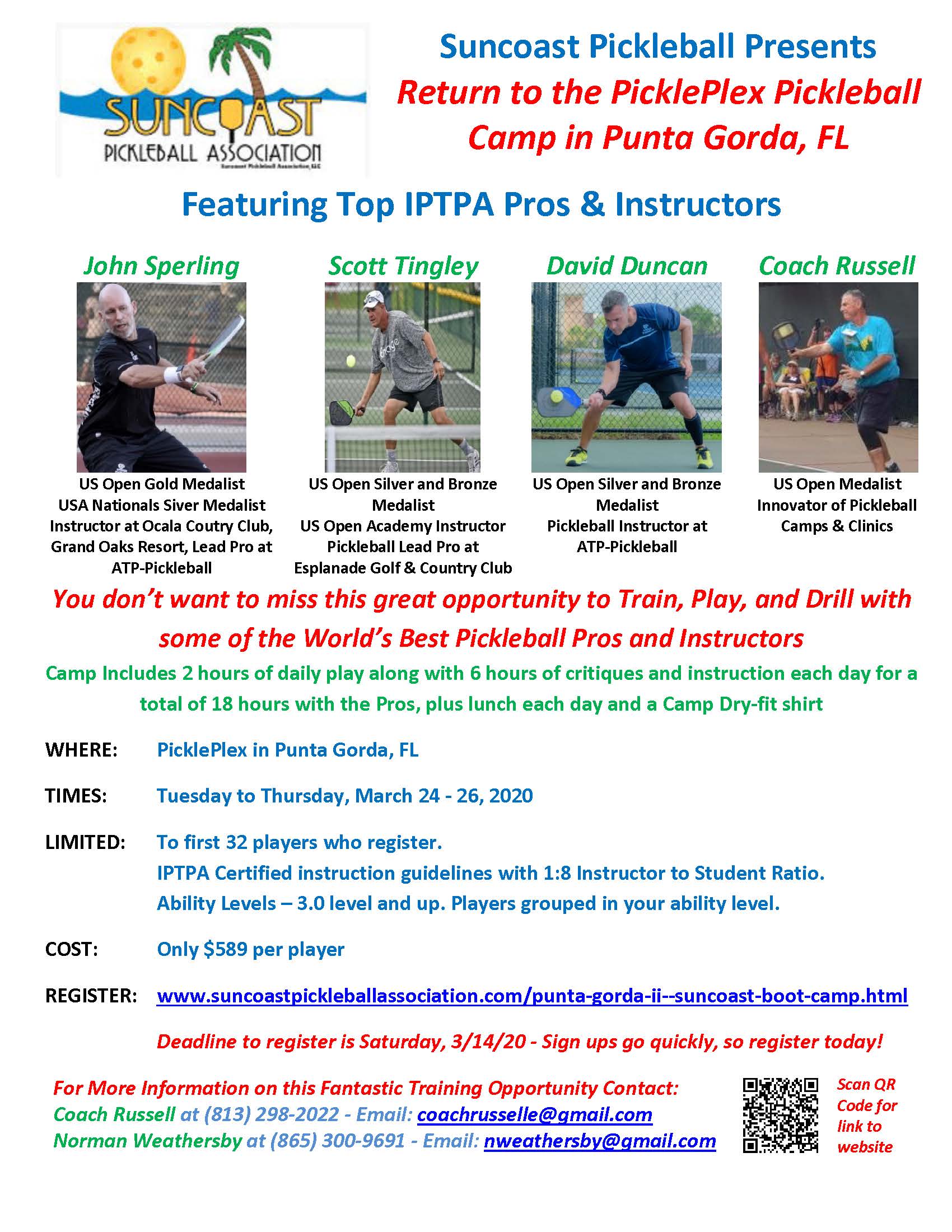
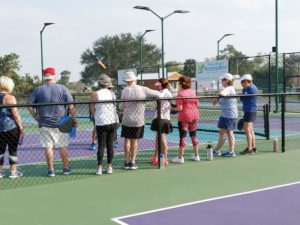
I had the pleasure of participating in a Suncoast Pickleball Camp in Punta Gorda this past week. What an amazing experience, and boy, did I learn a lot…under fire. The 4 pros, Barry Waddell, John Sperling, Scott Tingley and David Dunkin all kept a close eye on the 32 students, so much so, that 2 courts over from me one of the pros yelled out, “Terry, did I just see you step in the kitchen?”
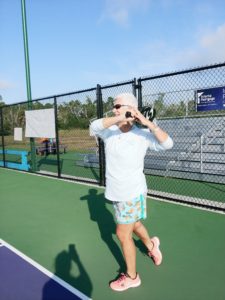
The camp started at 8:00 a.m. on 8 courts at the Pickleplex. If you don’t know what the Pickleplex is, it consists of 16 outdoor pickleball courts constructed on the Florida Southwestern College campus, and it literally put Punta Gorda on the pickleball map. Read this article here on how much $$$ the Pickleplex brought into the community.
We were divided into groups of 8 and had a different pro in the mornings and afternoons practicing: dinking, reset, lobs, serves, blocking and more, for 7 hours with a break for lunch. After 3 days, I’ll admit I was tired and sore.
It was an amazing experience and I would suggest anyone who is serious about pickleball and sharpening their skills should take a clinic or camp.
On the first day, pro, Barry Waddell, mentioned that there are 12 tremendous pickleball shots with subshots. I asked him to send them to me via email, and I will share them with you.
https://blog.pickleballcentral.com/2019/05/28/meet-the-pros-barry-waddel/
The 12 Pickleball Shots according to Barry Waddell:
There you go. Master these and you master the game of pickleball.

I had the pleasure of meeting with the new owners of Sarasota Pickleball Academy, Brian and Valerie McCarthy, and I am happy to say that they are down-to-earth and sincerely wonderful people. In fact, they are the kind of people you want to succeed in their next endeavor; buying the Stardust Roller Skating Rink and turning into a 12 indoor pickleball courts facility.
With the husband’s and wife’s familiarity with commercial real estate (shopping centers, marinas in the Keys, an olive grove in California, etc.) and their equal interest in pickleball, they agreed to undertake the massive project of rehabbing the old building located on 12th St and turning it into the first dedicated, indoor pickleball facility in USA.
They plan on opening in the fall of 2020 after putting in over a million dollars of improvements that will include a new roof, floors, HVAC and repaving of the parking lot.
Some of the programs planned are drop-in play, ability to reserve courts, clinics, lessons from area pros, veteran leagues, youth programs, and tournaments. There will be a coffee and juice bar, locker rooms with showers, a pro shop and possibly beer and wine available to encourage the after-play, social aspect.
>>>>>>>>>>>>>>>>>>>>>>>>>>>>>>>>>>>>>>>>>>>>>>>>>>>>>>>>>>>>>>>>>
To Order For Your Pets Click on The Picture…
>>>>>>>>>>>>>>>>>>>>>>>>>>>>>>>>>>>>>>>>>>>>>>>>>>>>>>>>>>>>>>>>>

As far as rates, there will be a membership program in place including a Snowbird plan.
I will plan a mixer in the spring to introduce the McCarthys to the Sarasota pickleball community so we can all give them a warm welcome.
For their press release. Roller Skating to Pickleball
Their website is SRQpickleball.com
Simone Jardim is one of the best, if not the BEST, female pickleball player. Simone graciously had a question and answer session on Facebook. I copied a few and posted here with the questions in red and the answers in black. Thank you, Simone!
How do you incorporate weight training in your fitness routine?
As of now I’m doing most of my training on court, So, some of my drills are designed to work on my cardio, some work on strengthening my quads. And I do a little of playing games.
What kind of diet do you follow? More carbs, protein, or balanced?
Balanced
What is the biggest thing that helped your singles game?
Fitness and angle shots.
I love playing PB 6 days a week but know I should be doing other exercises. What would you recommend?
Always good to do some body weight stuff, and if you are having any problems with body soreness make sure you stretch after and warm up before.
Aside from paddle sports, what is your favorite things to do?
Watch my kids play, watch movies or TV series, play board games with friends, travel, eat delicious food, listen to music, talk to family, listen to my girl sing, and sometimes do nothing.
What is your favorite place to play and why?
Home because I’m only a few minutes away from family.
Make sure you keep your paddle up and do your best to minimize movement with it and your body. The further out in front you can get it and then have some room to absorb the pace the better.Hey Simone! First off swfl misses you! Second, I play some pretty talented players this Friday that can hit pretty hard… how do you remember not to play someone else’s game/style? 😬Once you get pounded with the balls a couple of times…haha kidding but not really. Neutralize every hard hit and get your paddle up and ready girly. You can do it! Also don’t forget to show them your power when the opportunity comes! 💪
Is there anything you would like to see change?
Nothing big. I see the crossing the net plane rule as overly complicated, especially trying to determine if someone’s arm crossed the net plane before contact or if you waited until the ball recrossed the net before you can reach over.
Hi Simone! Now that I will have to play 3.5 in tournaments, what must I master that was not as important playing against 3.0s? Thanks!
As you move up in level know that some of the things you got away with at a lower level may not work with higher level players. For instance, it’s easier to over power someone lower level than you even if the ball is below the net, but if you play someone better who is ready for that shot you may need to consider a kitchen shot instead. Also, as you dink more just dinking over the net might not be the only thing you need to worry about, look to move the ball around to get an error.
What is your mindset before and during a tournament? Specifically, what do you do to mentally prepare for a tournament?
Well the reason I like to prepare is because I want to do everything and anything on my control to feel ready, which then gives me confidence. I control what I can and what I can’t… not much I can do about. The day in and day out grind builds character, is what defines me as an athlete. No matter how bad I feel or tired I try to push through especially those days. It’s easy to play when all feels well, but not when it doesn’t. During tournaments, I try to keep a routine and I always must watch my food intake, rest and anything else that may influence my performance.
What skill could most 4.0 players improve upon develop to 4.5 level?
Control of their shots whatever that shot is. If you are driving a 3rd shot it should be down and consistent enough to not get you and your partner in trouble. Drops should be good enough to get you and your partner in a position to score. You may not have mastered shot selection but you are aware of when to pull the trigger and when to play defense!
What are your thoughts about having line judges after playing most of the day without them. (Certified and trained, not just random people). Yay or Nay?
I think it helps, it takes pressure off of the players to make the close calls. Unfortunately we are not at the point where we can have them for all matches, but is better than not having them.
I have a quick question for you…is there a good way to learn how to pause before a shot? I tend to rush my shots, and I’ve been told that I rush a lot. I haven’t figured out yet how to consistently pause. Thanks! I’ve seen you play a number of times and you’re incredible!
Try to make a point to come to a full stop wherever you are on the court before your opponent hits the ball. That will give you plenty of time to react to the shot that is coming your way. See how that works and let me know.
Hey Simone’! I see more players…you, Riley and Lindsey Newman, Regina Franco, etc using 2 hands on your paddle for most of your defensive resets, especially in the transition area…why? More stability and strength to deal with the hard hits I’m guessing??
I feel my wrist can hold up when the ball is coming hard so it helps to keep it steady! 💪
They are using two hands for most of their dinks as well.
I usually do one hand unless I really need it for control.
And, what are the favorite car snacks? 😬
As I approach 40 I really need to watch what I eat. I have put on a few pounds just from being on the road. So need to get back to my routine ASAP.
}}}PEACE, LOVE AND PICKLEBALL SKIRT{{{
Several pros have said that drilling is important, but also say playing games against others at the same level is just as important for them because you cannot drill that kind of speed that happens in a game. What are your thoughts on that? And how does that apply, or not apply, to us 3.5 to 4.0 level players?
I believe one must do what works best for oneself. Everyone prepares differently. What might work for me, may or may not work for you. You must try different training regimens till you find the one that makes you better physically and mentally. My advice to all level of players is to find the balance that works for them. Once they find that balance attack it with purpose and results will come.

I love your tenacity on the court. What do you think about quick hopping the return of serve to get to the net?
For me personally it doesn’t work. I like to take my time and have space to hit the best return I can. As you get better you realize that it is more important to hit a quality shot rather than getting to the kitchen line! Some people have different views, which is completely ok.
Do you watch what you eat? If so what are your go to meals and snacks?
I try to. I eat what I like to eat, but usually not too much of it. My go to meal is rice and black beans and some sort of meat! Snacks I would have to say I try not to, but during tournaments it’s usually nuts, fruit, and lots of coconut water.
How much time do you spend drilling versus playing and what are your favorite drills?
I drill way more. Because I teach on a daily basis I get to drill lots with my clients. Since I’m so lucky because my clients are great players I can get in somewhere between 3-4 hours a day during summer and 4-6 during the busy season.
Simone Jardim if you weren’t coaching, what would be your optimal balance between playing and drills?
2 hours of tough practice. Drill for 1 hour and play the other hour.
Simone what can you say about “sandbaggers”? Feels like they take away the fun from the game / tourney …
Hopefully ratings will become more accurate and people will play at the level they belong. As a TD is difficult sometimes to know if players who are self rated are playing on the right level. However, once they play a tournament or two we are able to look at some data.
Do you have in your head, your shot placement strategy, before your previous shot is returned?
Most of the time unless I’m on defense than I’m thinking survive one more ball till I can actually reset a really good one
Do you base your shot selection on what your opponent is weakest at? Is everyone weaker at their dominant hand shoulder shot? It seems like at this level that hitting to the opponent’s back hand at their feet is something they all can “dig” and get back. Which leads to another question, the amazing digs you do from the feet at whatever part of the court and drop into the kitchen – how do you drill for that? Do you have someone smashing balls at you for a drill?
Yes on shot selection being based on opponent. What might work for one may not work for another. The right shoulder works for some players who sit more on their backhand but again some don’t. And one of my favorite drills is to feed a ball to my opponent that is easy and try to dig myself out of trouble.
Hi Simone….will the USAPA tournament rating system and the IPTPA rating system ever get in sync?
I have no idea. I do believe that as the sport grows more effort and energy will be put into clarifying these issues.
Hi Simone, how do you build confidence , and then keep it during the game?
Building confidence starts from practice and preparation. If during tournament play you start to make errors try to focus on the things you can control, your footwork, your tactics and your partner communication. It’s always good to call a time out when things are not going as planned. Then try to visualize what you looked like when you were practicing and how your body was positioned and body language is also extremely important. Stay positive even in times of trouble, believe you can find your rhythm again. Tournament play especially when there’s been some unforced errors on our side?
Trying to get my game to the next level and be more competitive. Any tip yes, that will have to come from drilling.
As monotonous as it can be to hit crosscourt dinks, for me it’s the best way to get consistency. Also, if you incorporate playing it out from there and focusing on that it should helps?
There is a little game you can play that might help. Play skinny singles crosscourt with someone and do the following for scoring. If you win the point with a winner it counts as a regular 1 point but if you or your opponent makes an unforced error it counts as 2 points!
Here’s the toughest question of all 😜. How do you manage practice, tournaments and travel with 2 children. Ensuring you are involved with their daily activities and having their needs met while still wanting to play as much as possible.
it takes a village! Honestly, I’m very lucky. Not only is Chadwick (husband and dad) involved with everything we do, but also we have amazing friends like Val and David Epstein to name a few. Our community is super involved with helping raise our children happy and healthy. We surround ourselves with great people who help shape our children. I believe that although we are always busy, our children see how hard we work to provide them everything they need. I love how proud they are of mom and we have a lot of family time.
Question on forehand. Should the wrist be bent on contact or in line with the arm? Hope that makes sense. Thanks for taking questions!
So for my forehand there are a few things going on. First I use a semi western grip to help generate more topspin. Then I lay my wrist back and get the head of the paddle under the ball, as I come through to make contact with the ball in front of me I extend my arm but continue to have my wrist laid back till I come over the ball to finish my stroke!
After you hit your forehand you change your grip for backhand and dinks/volleys? For return of serve do you prefer a slice? I had to go to YouTube to make sure I understood a semi western! Another video idea is to show us your hand position for the 2 handed backhand. I use your Prince paddle which has a longer grip but still not sure of my hand position for backhands.
For sure I can do that. And yes I’m used to going from my semi western grip to my continental grip from all my tennis years. Having my left hand on the paddle helps go back and forth.
If you are hitting a forehand with an undercut you use the continental grip, right?
Yes
What’s your favorite color?!?!
I have so many…but would say black, blue, orange and red… the only problem is the heat, so I will do a black skirt with white top. But most of my nice dresses are black. Very slimming!
What shoes and paddle do you usually use?
Disclaimer I’m sponsored by Tyrol and Prince. Here is the deal, they both listen to what I have to say. They provide me with the best equipment for me to succeed!
Sooooo how can I turn my deep serve into a sliced deep serve?
Do you already know how to slice the ball?
Trying. But I end up with tennis elbow every time.
Might need to look at your technique. As it shouldn’t hurt. The only thing without ever seeing you hit a ball, try to slow down your motion. Instead of creating slice by whipping your arm, think of grabbing the ball on your paddle as it slides through it. Does it make sense at all?
How many hours do u practice before a tournament?
it depends. If I’m playing singles I put in more hours cause I need to feel ready to run all day. I’m not a huge fan of working out, so I do most of my training on court. Starting to get ready for TOC next week, I will put in at least 20 hours before tournament.
When in a volley exchange at the kitchen, how and when should you reset the shot?
I usually choose to reset anytime I feel I’m unable to counter to my advantage. So if the attack is coming from high to low I’m usually going to reset.
As far as how, the sooner you can recognize that you are in trouble, get your paddle up and ready out in front to absorb pace. Your paddle and body should be doing little to no movement.